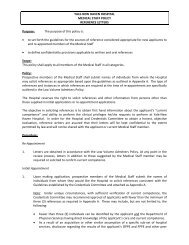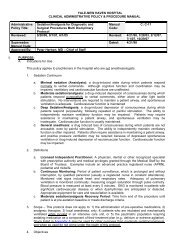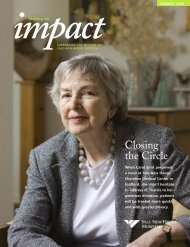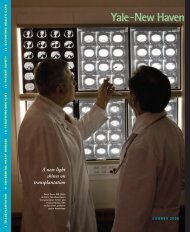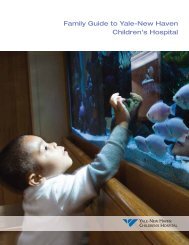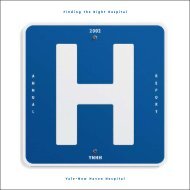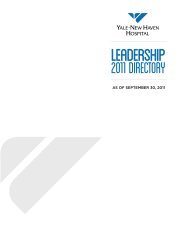Impact FALL 2007 - Yale-New Haven Hospital
Impact FALL 2007 - Yale-New Haven Hospital
Impact FALL 2007 - Yale-New Haven Hospital
You also want an ePaper? Increase the reach of your titles
YUMPU automatically turns print PDFs into web optimized ePapers that Google loves.
<strong>FALL</strong> <strong>2007</strong><br />
impact<br />
Making an<br />
SUPPORTING THE MISSION OF<br />
YALE-NEW HAVEN HOSPITAL<br />
Blessed to<br />
be Alive<br />
While his parents prayed, John Fiorita<br />
survived two open heart surgeries, a<br />
stomach surgery and treatment for a<br />
collapsed lung at <strong>Yale</strong>-<strong>New</strong> <strong>Haven</strong><br />
Children’s <strong>Hospital</strong>. He was just a year<br />
old. Now, two years later, he runs<br />
circles around his parents.
impact<br />
Making an<br />
<strong>FALL</strong> <strong>2007</strong><br />
Editor<br />
Jeannette Young<br />
Associate Editors<br />
Jessica Scheps<br />
Carol Cheney<br />
Writer<br />
Ross Grant<br />
4<br />
FEATURES<br />
COVER STORY<br />
Blessed to be Alive<br />
After being treated by almost every specialist at the children’s<br />
hospital, John Fiorita is now just a normal 3-year-old boy<br />
Principal Photographer<br />
Robert Lisak<br />
Additional Photographers<br />
Janice Baker<br />
Toni Fracasso<br />
Park Place Photographers, Inc.<br />
Ray Paige Photography<br />
Jessica Scheps<br />
8<br />
ON THE GROUND<br />
Giving Heart<br />
At 17, Frank Barbiero has mapped out his life,<br />
and volunteering is the first step<br />
Design and Production<br />
Cheney & Company<br />
Printing<br />
Harty Integrated Solutions<br />
<strong>Yale</strong>-<strong>New</strong> <strong>Haven</strong> <strong>Hospital</strong><br />
Office of Development<br />
PO Box 1849<br />
<strong>New</strong> <strong>Haven</strong>, CT 06508-1849<br />
(203) 688-9644<br />
www.ynhh.org/develop<br />
<strong>Impact</strong> is a quarterly publication<br />
of the <strong>Yale</strong>-<strong>New</strong> <strong>Haven</strong> <strong>Hospital</strong><br />
Office of Development for donors,<br />
volunteers and friends of the<br />
hospital.<br />
Copyright © <strong>2007</strong> <strong>Yale</strong>-<strong>New</strong> <strong>Haven</strong><br />
<strong>Hospital</strong>. All rights reserved. No<br />
part of this publication may be<br />
reproduced or transmitted by any<br />
means or in any form without<br />
written permission from YNHH.<br />
An EEO/AAP employer.<br />
10<br />
CANCER HOSPITAL CAMPAIGN<br />
Building Hope<br />
Architecture alone will save lives at the cancer hospital<br />
PROFILES<br />
12 John M. Letizia: Why I Gave<br />
15 Fred M. Bering: Giving with a Plan<br />
NEWS FROM YALE-NEW HAVEN HOSPITAL<br />
3 Top <strong>Hospital</strong> & By the Numbers<br />
6 Head & Heart<br />
7 Hats & Hogs, Silent Auction, Art and Baker Win<br />
9 Auxiliary Supports Gift to Women’s Health<br />
12 Thank You<br />
14 A Gift that Gives Back<br />
14 Letter from Marna Borgstrom<br />
16 Tax Credits
Top <strong>Hospital</strong><br />
YALE-NEW HAVEN HOSPITAL<br />
BY THE NUMBERS<br />
Two reports rank YNHH among the best<br />
Two recent reports by national publications<br />
showcase the growing reputation of<br />
<strong>Yale</strong>-<strong>New</strong> <strong>Haven</strong> <strong>Hospital</strong> as one of the<br />
country’s best hospitals.<br />
In July, U.S. <strong>New</strong>s & World Report<br />
named YNHH the 15th best hospital in<br />
the United States. It was the first time<br />
the hospital was listed in the publication’s<br />
elite Honor Roll of 18 top hospitals.<br />
The report also listed YNHH as one<br />
of the best in the nation in 10 of the 16<br />
medical specialties evaluated: cancer;<br />
digestive disorders; ear, nose and throat;<br />
endocrinology; geriatrics; gynecology;<br />
heart and heart surgery; kidney disease;<br />
psychiatry; and respiratory disorders.<br />
And in May, USA Today began its<br />
cover story by suggesting that residents<br />
living near YNHH are among the luckiest<br />
in the country, because of the hospital’s<br />
premier care.<br />
YNHH “has one of the nation’s lowest<br />
heart attack death rates, according to<br />
confidential data obtained by USA Today<br />
from a Medicare analysis of death rates at<br />
more than 4,000 hospitals,” the article<br />
reads.<br />
The hospital also ranks higher than<br />
the national and state averages in other<br />
critical categories: heart failure, pneumonia,<br />
surgical care and infection prevention.<br />
The government data—which has<br />
long been kept secret—was recently<br />
released to the public by the U.S. Department<br />
of Health and Human Services.<br />
It can be viewed at:<br />
www.hospitalcompare.hhs.gov<br />
U.S. <strong>New</strong>s & World Report reviewed 5,462<br />
hospitals nationwide for its <strong>2007</strong> list of<br />
America’s Best <strong>Hospital</strong>s. Of those, 173<br />
made the top rankings. And only 18 showed<br />
the “marked breadth of expertise” to be<br />
named to the honor roll. <strong>Yale</strong>-<strong>New</strong> <strong>Haven</strong><br />
<strong>Hospital</strong> was listed as the 15th best.<br />
SPECIALTY RANKINGS<br />
Geriatrics #7<br />
Psychiatry #9<br />
Gynecology #11<br />
Digestive Disorders #16<br />
Endocrinology #17<br />
Kidney Disease #19<br />
Respiratory Disorders #19<br />
851 million<br />
Total operating expenses,<br />
in dollars, in 2006<br />
122 million<br />
Free and uncompensated care,<br />
in dollars, given in 2006<br />
503,656<br />
Outpatient visits in 2006<br />
113,921<br />
Emergency room visits<br />
in 2006<br />
7,220<br />
Employees<br />
4,814<br />
Babies born at the <strong>Yale</strong>-<strong>New</strong><br />
<strong>Haven</strong> Children’s <strong>Hospital</strong> in<br />
2006<br />
5.2<br />
Average length of hospital<br />
stay, in days<br />
1Connecticut hospital listed on<br />
the U.S. <strong>New</strong>s & World Report<br />
Honor Roll of America’s 18 best<br />
hospitals in <strong>2007</strong><br />
<strong>FALL</strong> <strong>2007</strong> 3
COVER STORY<br />
John, center, with<br />
his older siblings,<br />
Matthew and Emma,<br />
at their home in<br />
Darien. After John<br />
survived his final<br />
surgery, his brother<br />
and sister were so<br />
grateful they now<br />
donate their birthday<br />
gifts to the toy closet<br />
at the <strong>Yale</strong>-<strong>New</strong> <strong>Haven</strong><br />
Children’s <strong>Hospital</strong>.<br />
MAKING AN IMPACT AT YALE-NEW HAVEN
Paul Fiorita and son John<br />
Blessed to be Alive<br />
Each evening during that trying month, as Paul Fiorita walked into the pediatric<br />
intensive care unit, a nurse would hand him a stethoscope.<br />
It became a ritual, a calming end to his<br />
mad dash after work up I-95 to the <strong>Yale</strong>-<br />
<strong>New</strong> <strong>Haven</strong> Children’s <strong>Hospital</strong>. He had<br />
no medical training, but with help from<br />
staff, Paul learned how to decode the subtle<br />
sounds in the stethoscope.<br />
He would kiss his wife and then sit<br />
next to his son’s hospital bed. Before<br />
hearing the official medical report, he<br />
would listen to the six-month-old’s heartbeat<br />
and strained breathing to make his<br />
own assessment.<br />
“I’d check if he was having a good or<br />
bad day,” Paul recalls.<br />
John Fiorita, breathing with the help<br />
of machines, was a warrior. He had<br />
already undergone one open-heart surgery<br />
(a second would come six months<br />
later) and dozens of tests and procedures.<br />
Now his lungs were collapsed, partially<br />
filled with fatty bile from his stomach.<br />
Doctors were working to determine the<br />
mysterious cause.<br />
Missy Fiorita, Paul’s wife, followed her<br />
own ritual during that month of waiting<br />
and watching. She slept in a cot next to<br />
John’s bed, waking up throughout the<br />
night as nurses and doctors made their<br />
rounds. In the morning, wearing pajamas,<br />
she joined the medical team as they studied<br />
John’s condition.<br />
The only time Missy left the hospital<br />
was to get a cup of coffee in the late<br />
morning. For meals, she joined the nurses<br />
in ordering out.<br />
“I wasn’t going to leave,” she says, two<br />
years later. “It was my job to be with<br />
John.”<br />
The job was much less difficult<br />
because they were part of the process,<br />
Paul and Missy say. Doctors at the children’s<br />
hospital make it a policy to include<br />
parents in medical decisions. As the medical<br />
team visits their child, parents are<br />
invited to participate. They can read the<br />
charts, if they wish, or use a stethoscope.<br />
“It isn’t just about making the family<br />
feel connected; it also improves care. No<br />
one knows a child like his parents,” says<br />
Dr. Michael Apkon, one of the many<br />
physicians who treated John, who now<br />
leads the children’s hospital.<br />
So while the team of doctors did sleep<br />
studies and bronchoscopies or consulted<br />
with specialists around the country, Paul<br />
and Missy also monitored John’s fluctuating<br />
condition. Eventually, the team<br />
decided to perform a difficult surgery that<br />
would prevent bile from entering his<br />
lungs. And as with his other surgeries—<br />
the first occurring when John was 12 days<br />
old—it was a success. Two years later, he’s<br />
as healthy as any other three-year-old.<br />
To thank <strong>Yale</strong>-<strong>New</strong> <strong>Haven</strong>, the two<br />
older Fiorita children, Matthew and<br />
Emma, decided to give their birthday<br />
gifts to the toy closet. And the family<br />
chose to help financially support the hospital’s<br />
family-centered programs, which<br />
depend on donor giving.<br />
“We’re blessed he’s still alive, and we<br />
never want to take that for granted,”<br />
Missy says. “The hospital walls became a<br />
safe haven for us during some very difficult<br />
trials for our family. All I have to do<br />
now is to put my three-year-old in the<br />
bathtub and I’m reminded of <strong>Yale</strong>-<strong>New</strong><br />
<strong>Haven</strong> and the miracles this hospital<br />
performs each and every day. How could<br />
one not want to remain part of that”<br />
Of course, being a normal kid also<br />
means John gets into his fair share of<br />
trouble. “We went from praying for him<br />
to disciplining him. It’s quite a change,<br />
but it’s a good change,” Paul says. =<br />
<strong>FALL</strong> <strong>2007</strong> 5
Dr. Michael Apkon was appointed vice<br />
president and executive director of the<br />
<strong>Yale</strong>-<strong>New</strong> <strong>Haven</strong> Children’s <strong>Hospital</strong><br />
in 2006. He was previously the vice<br />
president for performance management<br />
at <strong>Yale</strong> <strong>New</strong> <strong>Haven</strong> Health System, overseeing<br />
clinical and operational improvements<br />
across a three-hospital system.<br />
Head&Heart<br />
Balancing the two sides of quality child medicine<br />
In 1946, a group of pediatric doctors at<br />
<strong>Yale</strong>-<strong>New</strong> <strong>Haven</strong> <strong>Hospital</strong> suggested a<br />
novel approach. Allowing mothers to<br />
share a room with their newborns, they<br />
reasoned, would make the hospital visit<br />
less painful for both.<br />
The hospital was the first to offer<br />
rooming-in to mothers, and thus became<br />
a national leader in the movement to<br />
care for the emotional needs of hospitalized<br />
children. Other programs followed:<br />
art, music, drama, sibling activities,<br />
involving parents in morning rounds, and<br />
most of all, play.<br />
“One of the most natural things for<br />
children is play. Getting them out of<br />
bed—giving them a reason to get out of<br />
bed—is part of the healing process,” says<br />
Dr. Michael Apkon, vice president and<br />
executive director of the <strong>Yale</strong>-<strong>New</strong> <strong>Haven</strong><br />
Children’s <strong>Hospital</strong>.<br />
Child medicine is a unique challenge<br />
for hospital staff. Because of birth<br />
defects and the many changes children<br />
undergo during the early years of life,<br />
the variety of conditions is greater than<br />
in adult hospitals. Doctors often<br />
encounter rare illnesses with little medical<br />
precedent. As a result, the amount of<br />
specialization and staffing required to<br />
run a comprehensive maternity and pediatric<br />
hospital is very high.<br />
Families also need social services and<br />
facilities that support the medicine. Yet<br />
family-centered care is rarely covered<br />
through medical billings. “It usually<br />
only happens through philanthropy,”<br />
Apkon says.<br />
These two factors—specialization and<br />
family-centered care—increase the cost<br />
of care at YNHH by $5 to $10 million a<br />
year. If it isn’t funded through donations,<br />
the children’s hospital would not be able<br />
to offer the level of care that allows children<br />
like John Fiorita to survive. (John is<br />
pictured above with his mother, Missy.)<br />
<strong>Yale</strong>-<strong>New</strong> <strong>Haven</strong> Children’s <strong>Hospital</strong> is<br />
Connecticut’s only accredited level 1<br />
trauma unit. Some of its other unique<br />
services include: mechanical heart and<br />
lung support for critically ill infants and<br />
children, and bone marrow and liver<br />
transplants. But they come at a price.<br />
“It’s an incredible experience to be<br />
involved in some of the most significant<br />
moments for a parent and child, both<br />
good and bad,” Apkon says. “It carries<br />
with it a lot of responsibility.”<br />
6<br />
MAKING AN IMPACT AT YALE-NEW HAVEN
Hats&Hogs<br />
A pack of bikers makes kids happy<br />
“ SERVE LOVE” FUNDRAISER<br />
More than 70 people attended the<br />
fifth annual Serve Love silent auction,<br />
held at the <strong>2007</strong> Pilot Pen tennis<br />
tournament. Guests attended a buffet<br />
brunch and then bid on more than<br />
40 items, including stuffed animals,<br />
tickets to the Jon Stewart show and a<br />
weekend at a rental home in Vermont.<br />
Afterward, participants attended<br />
opening day tennis matches.<br />
Serve Love raised approximately<br />
$15,000. The event was started by<br />
Jane Farrington, shown above with<br />
her spouse, Michael Schaefer, their<br />
son, James, and Vin Petrini, YNHH<br />
senior vice president of public affairs.<br />
It was a calm summer Sunday, except<br />
for the rumble. More than 300 motorcyclists<br />
in leather and denim rode through<br />
<strong>New</strong> <strong>Haven</strong> June 10 on their way to<br />
<strong>Yale</strong>-<strong>New</strong> <strong>Haven</strong> Children’s <strong>Hospital</strong>. As<br />
a part of the third annual Don’s Hat<br />
Rack Ride, the bikers visited a dozen<br />
young patients to give them treats and let<br />
them sit on their hogs.<br />
But mostly, they came to replenish the<br />
hat rack, located in the infusion room at<br />
the pediatric specialty clinic. While children<br />
receive treatment, they can see the<br />
hats and decide which one they want to<br />
keep.<br />
“All motorcyclists brought hats,” said<br />
Jessica B. Scheps, manager of special<br />
events at YNHH. “The hats could be silly,<br />
practical, cool or sporty. The purpose is<br />
for children going through chemotherapy<br />
to be able to make a choice of their own.”<br />
Don’s Hat Rack was originally started<br />
in memory of Donald Perrotti, a patient<br />
at the children’s hospital, who lost his<br />
six-year battle with Ewing’s Sarcoma<br />
in 1998.<br />
“We get to see the kids’ faces. We<br />
bring the gifts to them and to see their<br />
smiles is amazing,” Toni Fracasso, whose<br />
family started the charity, told <strong>New</strong>s<br />
Channel 8.<br />
And after wowing the children with<br />
their motorcycles, the group rode off to a<br />
charity barbecue in West <strong>Haven</strong>, where<br />
organizers collected $11,000 in donations<br />
to the children’s hospital.<br />
Pablo Rosa, a patient at <strong>Yale</strong>-<strong>New</strong> <strong>Haven</strong><br />
Children’s <strong>Hospital</strong>, had a chance to fulfill<br />
his dream of sitting atop a Harley.<br />
ART AND BAKER WIN<br />
IN HEALING KIDS<br />
Janice Baker, coordinator of the child<br />
life arts and enrichment program at<br />
YNHCH, recently received the <strong>2007</strong> Art<br />
Achievement in healthcare award by<br />
the Guilford Art Center.<br />
Baker promotes art as a therapeutic<br />
tool for helping pediatric patients<br />
cope with hospitalization and illness<br />
through poetry, music, daily art activities,<br />
performance programs and digital<br />
storytelling. She helped produce a<br />
book of patient poems and songs<br />
called “I Am,” which is distributed to<br />
pediatric patients at YNHCH.<br />
“The presence of the arts in the<br />
hospital helps to create a safe, caring,<br />
healing environment for children and<br />
families,” said Baker.<br />
<strong>FALL</strong> <strong>2007</strong> 7
on the ground<br />
Giving Heart<br />
Frank Barbiero is part<br />
of an army of volunteers<br />
at the hospital, who<br />
together logged 72,982<br />
hours in 2006<br />
With a swift and practiced hand, Frank<br />
Barbiero loads the tray. Chips. Sandwich.<br />
Cookies and condiments. He runs to the<br />
fridge for a container of juice. Then he<br />
studies the meal with a stern gaze, and<br />
finally delivers it.<br />
He’s rosy cheeked and not yet 17. A<br />
baseball player and aspiring surgeon. And<br />
today Frank, a volunteer, is serving lunch<br />
to cancer patients.<br />
Quickly he marches to an older<br />
woman in the corner. He takes her order<br />
and rushes back to the lunch cart. Carefully<br />
he prepares her tray with a few brisk<br />
motions. Head down, focused.<br />
“First time I’ve seen him work all<br />
week,” a nurse jokes as she passes by.<br />
Finally Frank cracks a smile. And as if<br />
the clouds parted, it’s suddenly clear how<br />
this young man’s understated enthusiasm<br />
brightens the room.<br />
Around him in the YNHH medical<br />
oncology treatment center, 20 patients of<br />
various ages sit in hospital recliners. Each<br />
is attached to an IV infusion pump. Some<br />
read magazines or real estate listings.<br />
Others work sudoku puzzles, watch TV<br />
or type on laptops. They’re all trying to<br />
go about life as usual. But in moments,<br />
the air of the room seems filled with a<br />
heavy spirit.<br />
Frank and the others at the lunch cart<br />
provide a spark. He moves from patient<br />
to patient as Sheryl Sobolewski heats<br />
8<br />
MAKING AN IMPACT AT YALE-NEW HAVEN
AUXILIARY SUPPORTS GIFT TO WOMEN’S HEALTH<br />
Twenty years ago, the <strong>Yale</strong>-<strong>New</strong> <strong>Haven</strong><br />
<strong>Hospital</strong> mobile mammography program<br />
began with a converted RV, which traveled<br />
throughout Southern Connecticut to<br />
offer screenings outside grocery stores<br />
and senior centers. The purpose of the<br />
program hasn’t changed since then, but<br />
it now uses a new 40-foot-long digital<br />
mammography van, the only one of its<br />
kind in <strong>New</strong> England.<br />
The YNHH Auxiliary donated $100,000<br />
toward the vehicle, which replaces one<br />
purchased in 1996. Outfitted with stateof-the-art<br />
equipment and certified mammography<br />
technicians, the mobile unit<br />
represents a collaboration between the<br />
hospital, the <strong>Yale</strong> Cancer Center and the<br />
Hill Health Center.<br />
“The idea is to bring mammography<br />
screening to the community. This new<br />
van will help us better accomplish that<br />
mission,” said Shirley Pinette, manager of<br />
the YNHH Breast Center, who has<br />
worked at the hospital for 28 years.<br />
The 1,000-member Auxiliary helped<br />
purchase the older van, and was committed<br />
to replace it when it recently began<br />
having mechanical problems. The group<br />
raises money through fundraising events<br />
and hospital gift shop sales. Every year,<br />
members choose several programs to<br />
support, which might not be funded<br />
otherwise.<br />
“Our one goal is to raise money for<br />
the hospital,” said Kathrine Neville, president<br />
of the Auxiliary. “We do myriad<br />
things with the help of donations from<br />
our membership. We have always been<br />
adamant about the mammography van.<br />
It’s for women who would have difficulty<br />
getting a screening if the van didn’t<br />
come to them.”<br />
Digital mammography has a number<br />
of advantages over film: the program can<br />
do more screenings per hour, technicians<br />
can download images quickly for physician<br />
analysis, and it has been proven<br />
more effective in screening women 50<br />
years old and younger.<br />
The new digital mammography van travels<br />
throughout Southern Connecticut.<br />
“The auxiliary has been extremely<br />
generous to us,” Pinette said. “Like us,<br />
they want to make certain that women<br />
are obtaining their screening annually,<br />
and that they get whatever care they<br />
may need.”<br />
The digital mobile mammography<br />
service is offered Monday through Saturday<br />
from 7:30 a.m. to 4 p.m. To schedule<br />
the van for a location or to make an<br />
appointment, contact the Breast Center<br />
at (203) 688-6800.<br />
Becoming a member of the <strong>Yale</strong>-<strong>New</strong><br />
<strong>Haven</strong> <strong>Hospital</strong> Auxiliary costs just $25<br />
a year. To join, contact the Auxiliary<br />
office at (203) 688-5717.<br />
Sheryl Sobolewski, right, has worked for<br />
<strong>Yale</strong>-<strong>New</strong> <strong>Haven</strong> <strong>Hospital</strong> for 20 years. In<br />
the last four years she has mentored more<br />
than 30 volunteers at YNHH’s two oncology<br />
treatment centers.<br />
soup in the microwave. The two work<br />
around each other, reaching for bananas<br />
or Jello as they assemble trays. And then,<br />
a minor disaster.<br />
“We ran out of egg salad,” Sobolewski<br />
says over her shoulder.<br />
They confer about alternatives and<br />
Frank goes to speak with the patient.<br />
Sobolewski watches the exchange before<br />
pulling out a new tray. She supervises and<br />
mentors a dozen volunteers at YNHH’s<br />
two oncology treatment centers, usually<br />
working with them side by side.<br />
“It gets crazy around lunch,” she says,<br />
“but Frank is a good volunteer. I was<br />
impressed with him the first time I saw<br />
him.”<br />
Frank, serving in a summer youth volunteer<br />
program, comes to the treatment<br />
center three days a week to dish up lunch<br />
and hand out blankets. He’s part of an<br />
army of volunteers at the hospital, who<br />
together logged 72,982 hours in 2006.<br />
And with Frank, there’s an added<br />
bonus. He doesn’t mind teasing. The<br />
nurses and doctors can’t help but joke<br />
with him. The patients seem immediately<br />
taken by his kind, affectionate manner.<br />
“I’m the new guy,” he says, smiling.<br />
“They know I can take it. I’m part of the<br />
team now.” =<br />
VOLUNTEERING AT YNHH<br />
Each year, the hospital depends on more<br />
than 1,500 volunteers of all ages. They help<br />
by reading to children and elders, working<br />
in the gift shop or at information desks,<br />
talking to new patients about what to<br />
expect during their visit, giving tours of the<br />
hospital, and even sometimes serving<br />
lunch.<br />
For more information, call: (203) 688-2297<br />
or online: www.ynhh.org/general/vol.html<br />
<strong>FALL</strong> <strong>2007</strong> 9
CANCER HOSPITAL CAMPAIGN<br />
Building<br />
hope Healing<br />
architecture isn’t only<br />
academic. Studies show design<br />
can reduce hospital stays, pain,<br />
stress and staff fatigue<br />
Architectural renderings courtesy of Shepley, Bulfinch, Richardson & Abbott of Boston<br />
The <strong>Yale</strong>-<strong>New</strong> <strong>Haven</strong> Cancer <strong>Hospital</strong> may one day play a role in finding<br />
the cure for cancer. But in the meantime, the design of the building<br />
alone will likely save hundreds of lives.<br />
Key design features of the cancer<br />
hospital have been linked to improved<br />
patient and family stress and healing, staff<br />
morale and effectiveness, and the overall<br />
quality and cost of healthcare, according<br />
to a landmark 2004 study which compiles<br />
the results of 600 other studies.<br />
By one essential yardstick—the length<br />
of hospital stays—patients in welldesigned<br />
hospitals are released an average<br />
of two to three days earlier than in poorly<br />
designed hospitals.<br />
“Not only is there a very large body<br />
of evidence to guide hospital design, but<br />
a very strong one. A growing scientific<br />
literature is confirming that the conventional<br />
ways hospitals are designed<br />
contribute to stress and danger,” says the
Inside the lobby<br />
(left), natural light<br />
and warm building<br />
materials such as<br />
bamboo and maple<br />
will create a calm,<br />
inviting atmosphere.<br />
The healing garden<br />
outside (right), will<br />
be visible from many<br />
patient rooms in the<br />
14-story cancer<br />
hospital. Exposure to<br />
nature has been<br />
shown to improve<br />
healing and shorten<br />
hospital stays.<br />
study, funded by the California-based<br />
Center for Health Design.<br />
This evidence is addressed in every<br />
facet of the cancer hospital’s architecture:<br />
natural lighting, green space, improved<br />
ventilation, and single-patient rooms.<br />
“We know the environment of a<br />
hospital helps in the healing process. We<br />
considered this from the start,” says<br />
Norman G. Roth, YNHH’s senior vice<br />
president of administration.<br />
Once finished in 2009, the $497<br />
million cancer hospital won’t even look<br />
like a medical center.<br />
“It will be warm and inviting. The<br />
rooftop garden will give it the feeling of a<br />
city park. It won’t feel like you’re going<br />
into a hospital, but it’s a place that will<br />
emphasize healing,” says Angela E.<br />
Watson, principal designer with Boston<br />
architects Shepley, Bulfinch, Richardson<br />
& Abbott.<br />
To determine the best design, planners<br />
held focus groups, in which patients and<br />
family members toured existing hospitals<br />
to suggest changes. Their input led to<br />
larger patient rooms, overnight rooms for<br />
visitors, and the garden, visible from<br />
many of the hospital rooms.<br />
“We want to be able to say legitimately<br />
that families and patients helped us<br />
<strong>Yale</strong>-<strong>New</strong> <strong>Haven</strong> <strong>Hospital</strong> is now building<br />
the foundation of the capital campaign for<br />
the new cancer hospital. Read more about<br />
it in the next issue of <strong>Impact</strong>.<br />
design and equip the hospital. This building<br />
should reflect what they see as their<br />
needs, not just what we think they need,”<br />
Roth says.<br />
And computers did their part. Digital<br />
models showed how natural light would<br />
enter hospital rooms at different times of<br />
day and different seasons of the year.<br />
The link to nature is essential. Patients<br />
exposed to natural light sleep better,<br />
recover faster, perceive less pain and<br />
require less pain medication. By “simply<br />
viewing nature” patients experience less<br />
stress and depression, and find a positive<br />
distraction from pain, the study says.<br />
“Daylight is so important for human<br />
health. Not just for patients, but also<br />
caregivers. People will want to work in<br />
this hospital, and people will be healed<br />
here,” Watson says. =<br />
Source: The Role of the Physical Environment in the <strong>Hospital</strong><br />
of the 21st Century: A Once-in-a-Lifetime Opportunity,<br />
Report to The Center for Health Design for the Designing<br />
the 21st Century <strong>Hospital</strong> Project, September, 2004<br />
Number of studies showing health<br />
benefits of design improvements<br />
IMPROVED VENTILATION<br />
Reduced risk of healthcare workers<br />
contracting infectious diseases 4<br />
Reduced airborne infectious 11<br />
SINGLE-PATIENT ROOMS<br />
Lower infection rates 16<br />
Easier to decontaminate 1<br />
Reduced noise, which:<br />
Improves sleep 5<br />
Lowers blood pressure and stress 4<br />
Decreases medication errors 3<br />
BRIGHT NATURAL LIGHTING<br />
Less depression 7<br />
Shorter hospital stays 6<br />
Improved sleep and<br />
circadian rhythms 1<br />
Less need for pain medication 1<br />
Reduced medication errors 2<br />
CENTRALIZED GARDEN<br />
Quicker recovery from stress 4<br />
Less pain perceived 4<br />
Less need for pain medication 2<br />
Lower blood pressure 2<br />
Opportunities for positive escape<br />
for staff and patients 3<br />
Heightened patient and family<br />
satisfaction with care 7<br />
<strong>FALL</strong> <strong>2007</strong> 11
THANK YOU<br />
Stuart Robinson, Marna Borgstrom<br />
In Gratitude<br />
PROFILE<br />
“I had just started law school when my best friend passed away. To cheer myself up, I went<br />
Why I Gave<br />
I was 22 when my best friend died of<br />
cancer. For two years he fought it. Week<br />
after week he went to Manhattan for<br />
treatment, taking the bus from Staten<br />
Island. And many of those weeks I traveled<br />
with him.<br />
The doctors put him in the children’s<br />
ward. It was the most devastating place<br />
I’d ever been—so many sick children. But<br />
I appreciated what a true cancer hospital<br />
could do. They cared for the families<br />
along with the patients.<br />
Recently, I pledged $10,000 to support<br />
the new <strong>Yale</strong>-<strong>New</strong> <strong>Haven</strong> Cancer <strong>Hospital</strong>.<br />
Then I learned about the hospital’s<br />
family-centered design—the meditation<br />
garden and rooms for families and visitors.<br />
The designers were clearly thinking<br />
John M. Letizia, Esq.<br />
to see Woman of the Year, starring Katharine Hepburn. It was just what I needed. So I wrote<br />
Katharine a grateful letter, and she wrote back: “That was such a really nice letter—made<br />
me happy—thank you. … Good luck.” Her note was so inspiring, it helped me get through<br />
this. I still look at it for inspiration.”<br />
about everyone who comes into a hospital,<br />
not just the patients. I was so impressed I<br />
increased my gift to $25,000. I do not<br />
want the hospital to have to cut corners.<br />
My wife and I are younger than most<br />
donors, but decided the time was right to<br />
give. We feel strongly that you should<br />
donate whenever you can, not just when<br />
you’re older, and when your donation can<br />
really make a difference.<br />
Just a year after my best friend died,<br />
my father also died of cancer. It was so<br />
hard on us. It took years for my family<br />
to recover. That’s why this cancer hospital<br />
is so important to us all. It will be a<br />
hospital that welcomes families, that<br />
offers healing to everyone.<br />
On a lovely mid-June evening, <strong>Yale</strong>-<br />
<strong>New</strong> <strong>Haven</strong> <strong>Hospital</strong> held its fifth<br />
annual “In Gratitude” reception<br />
to thank its largest donors (those<br />
giving more than $10,000). A few<br />
hundred individual, foundation<br />
and corporate donors attended the<br />
event, held at the <strong>New</strong> <strong>Haven</strong><br />
Country Club.<br />
Marna Borgstrom, YNHH<br />
president and chief executive<br />
officer, said the evening was an<br />
opportunity to celebrate the<br />
accomplishments donor support<br />
has made possible. Joseph<br />
Crespo, chairman of the Board<br />
of Trustees, said <strong>Yale</strong>-<strong>New</strong> <strong>Haven</strong><br />
<strong>Hospital</strong> continues to be the hospital<br />
of choice for the communities it<br />
serves. He also said the hospital<br />
had a productive year and had<br />
more than 50,000 inpatient admissions<br />
and over 500,000 visits to the<br />
various clinics. Marvin Lender,<br />
chairman of the Development<br />
Committee, introduced the<br />
evening’s featured speaker, Jim<br />
Zielinski, a U.S. Army veteran and<br />
financial adviser, who described<br />
how grateful he was for the<br />
hospital’s caring medical staff.<br />
12<br />
MAKING AN IMPACT AT YALE-NEW HAVEN
(L–R) Marna Borgstrom, John Fenn, MD,<br />
Natalie Fenn, Myrna Baskin, Peter Herbert, MD,<br />
Maureen Herbert<br />
(L–R) Alyssa Blume, Helaine Lender, Richard<br />
Edelson, MD, Peter Blume, MD<br />
(L–R) Sperie Perakos, Marna Borgstrom,<br />
Gerry Lees, Nancy Brown<br />
Cancer <strong>Hospital</strong> Discussion<br />
At the <strong>New</strong> <strong>Haven</strong> Lawn Club, 60 guests<br />
joined hospital staff for a May luncheon<br />
and discussion about the <strong>Yale</strong>-<strong>New</strong> <strong>Haven</strong><br />
Cancer <strong>Hospital</strong>. Marvin Lender,<br />
chairman of the YNHH Development<br />
Committee, pointed out that the cancer<br />
hospital will be the largest building ever<br />
to be built in <strong>New</strong> <strong>Haven</strong>. Jonathan<br />
Bush, co-chair of the Cancer <strong>Hospital</strong><br />
Campaign Committee, emphasized that<br />
the cancer hospital will allow not only<br />
cutting-edge care, but also research.<br />
Marna Borgstrom, president and chief<br />
executive officer, said the cancer hospital<br />
will be the newest in a long history of<br />
major advancements during the hospital’s<br />
181 years.<br />
Norman Roth, senior vice president<br />
of administration, described how the<br />
cancer hospital was designed to incorporate<br />
a more natural healing process with<br />
innovations in sustainability and energy<br />
consumption. And Dr. Peter Herbert,<br />
chief of staff and senior vice president of<br />
medical affairs, told guests about the<br />
existing cancer expertise at the hospital,<br />
which treats 4,000 cancer patients a year.<br />
Norman Roth<br />
Peter Herbert, MD<br />
(L–R) Marvin Lender,<br />
F. Patrick McFadden<br />
(L–R) Janette Parker, Henry Parker,<br />
Gloria Schoolfield<br />
<strong>FALL</strong> <strong>2007</strong> 13
DEVELOPMENT STAFF<br />
Dear Friends,<br />
Welcome to the first issue of <strong>Impact</strong>. This publication, as the name suggests,<br />
will highlight the impact made by <strong>Yale</strong>-<strong>New</strong> <strong>Haven</strong>’s many supporters. We<br />
have endeavored to record a few of their stories, and we truly hope you find<br />
them interesting, and an inspiration as well.<br />
What amazes me most about these stories and the faces in the photos is<br />
that despite their differences, each person has been touched by experiences<br />
at our hospital. And in response, they have chosen to give of themselves.<br />
We have all, in some way, experienced the impact of <strong>Yale</strong>-<strong>New</strong> <strong>Haven</strong><br />
<strong>Hospital</strong>. All of us who work to support the mission of <strong>Yale</strong>-<strong>New</strong> <strong>Haven</strong><br />
<strong>Hospital</strong> share a goal of enhancing the positive impact our <strong>Hospital</strong> can<br />
have on our patients, their families, and on the larger community. And we<br />
are especially proud that our work together has continued to advance the<br />
<strong>Hospital</strong>’s national recognition as demonstrated by our inclusion on the<br />
U.S. <strong>New</strong>s & World Report Honor Roll of best hospitals this year.<br />
Thank you for taking a moment to look through this issue. I hope it<br />
reinforces your own decision to be part of the <strong>Yale</strong>-<strong>New</strong> <strong>Haven</strong> family.<br />
Thank you for your ongoing support of all that we do.<br />
Warmest regards,<br />
Susan St. Onge<br />
Chief Development Officer<br />
(203) 688-8724<br />
susan.stonge@ynhh.org<br />
Myrna Ceccorulli<br />
Coordinator, Gift Support Services<br />
(203) 688-8723<br />
myrna.ceccorulli@ynhh.org<br />
John Dixon<br />
Director, Planned Giving<br />
(203) 688-5902<br />
john.dixon@ynhh.org<br />
Christine Franquemont<br />
Director, Institutional Giving<br />
(203) 688-5956<br />
christine.franquemont@ynhh.org<br />
Melody Harrison<br />
Coordinator, Gift Support Services<br />
(203) 688-8730<br />
melody.harrison@ynhh.org<br />
Jessica Scheps<br />
Manager, Special Events<br />
(203) 688-8727<br />
jessica.scheps@ynhh.org<br />
Michael Seeley<br />
Director, Major Gifts<br />
(203) 688-3582<br />
michael.seeley@ynhh.org<br />
Alison Smith-Marcinek<br />
Development Officer, Major Gifts<br />
(203) 688-4394<br />
alison.marcinek@ynhh.org<br />
Virginia Sorrentino<br />
Development Assistant<br />
(203) 688-8720<br />
virginia.sorrentino@ynhh.org<br />
Jamy Stenger<br />
Development Assistant<br />
(203) 688-1031<br />
jamy.stenger@ynhh.org<br />
Qaya Thompson<br />
Gift Support Services Assistant<br />
(203) 688-7061<br />
qaya.thompson@ynhh.org<br />
Lisa VanDerMaelen<br />
Executive Assistant<br />
(203) 688-8722<br />
lisa.vandermaelen@ynhh.org<br />
Scotti Williams<br />
Development Officer, Major Gifts<br />
(203) 688-9571<br />
scotti.williams@ynhh.org<br />
Rebecca Yao<br />
Director, Development<br />
Operations<br />
(203) 688-8731<br />
rebecca.yao@ynhh.org<br />
Jeannette Young<br />
Director, Communications<br />
and Annual Fund<br />
(203) 688-8728<br />
jeannette.young@ynhh.org<br />
Marna P. Borgstrom<br />
President and Chief Executive Officer<br />
PLANNED GIVING<br />
A GIFT THAT GIVES BACK<br />
The concept of the charitable gift annuity<br />
in America dates back to 1843, when a<br />
Boston merchant donated money to the<br />
American Bible Society in exchange for a<br />
flow of payments. Today, the concept<br />
includes tax benefits for donors.<br />
“Gift annuities are some of the most<br />
popular gifts in recent years,” says John<br />
W. Dixon, YNHH’s director of planned giving,<br />
who joined the development department<br />
this year after 30 years in trust management.<br />
“If you have money in a CD you’re<br />
lucky if you get 5 percent return, but with<br />
this type of planned gift, you get considerably<br />
more. You can also designate your<br />
gift be used for a specific purpose that is<br />
most meaningful to you,” Dixon says.<br />
Donors receive tax deductions of about<br />
half the size of the gift. The interest rate<br />
depends on the donor’s age. Once a<br />
contract is signed, that rate is guaranteed<br />
for life.<br />
Deferring payment increases the annuity.<br />
For example, if you donated at age 60,<br />
but waited to receive payments until you<br />
were 65, the annuity rate increases from<br />
5.7 to 7.7 percent. If you waited until you<br />
were 70 the rate jumps to 10.7 percent.<br />
APPROXIMATE DEDUCTION<br />
AS PERCENT OF ORIGINAL GIFT<br />
Age Rate of Return Deduction<br />
50 5.3 32%<br />
60 5.7 38%<br />
70 6.5 44%<br />
80 8.0 52%<br />
90+ 11.3 59%<br />
For the hospital, the gifts help develop<br />
a strong bond between the institution<br />
and the benefactor.<br />
“We’re building a relationship with<br />
these donors for life,” Dixon says.<br />
14<br />
MAKING AN IMPACT AT YALE-NEW HAVEN
PROFILE<br />
The letter, which has guided Fred M.<br />
Bering’s life, was written on plain white<br />
paper. His father’s flowing German script<br />
described what was expected of young<br />
Frederick as he began his fifteenth year.<br />
It was 1936. Stuttgart. Two years later,<br />
Bering fled Germany for America, carrying<br />
$9 and his father’s letter.<br />
“My parents knew they couldn’t leave,”<br />
he recalls. “A lot of the Jewish parents<br />
were sending their children away. They<br />
Fred M. Bering<br />
Giving with a Plan<br />
had to. My mother still got out in ’41<br />
with a handbag and nothing else. My<br />
father didn’t make it.”<br />
Bering found a job as stock boy in a<br />
corset factory in Queens. In 1948, he met<br />
his wife, Irmi Ann, and they eventually<br />
moved to Connecticut. It wasn’t until two<br />
years ago, after Irmi Ann passed away,<br />
that he again found the letter from his<br />
father.<br />
If you should find yourself in a position<br />
where you have more than you need for<br />
yourself, think of those who are less fortunate,<br />
the letter read.<br />
“When you’re 15 years old, you don’t<br />
pay much attention to what your father<br />
tells you. You think you know more. Yet<br />
basically he predicted the life I would<br />
live,” Bering says.<br />
In 1997, Bering had a triple bypass<br />
heart surgery performed by Dr. John A.<br />
Elefteriades at YNHH. During the surgery,<br />
he developed a connection to the<br />
staff. So when Bering sold his house last<br />
year, he decided to give some of the money<br />
to support the work of Elefteriades, who<br />
now runs the Center for Aortic<br />
Aneurysms at the hospital. But he also<br />
needed to set aside funds for living<br />
expenses. A charitable gift annuity proved<br />
the ideal choice.<br />
“It’s really a win-win,” says John W.<br />
Dixon, director of planned giving for<br />
YNHH. “The donor can make a charitable<br />
contribution to the hospital in<br />
exchange for an income stream for life,<br />
and an income tax deduction the year<br />
that the gift is made.”<br />
The benefits are dramatic. Bering<br />
gave $300,000, and last year received a<br />
$163,000 tax deduction. Because he is 86,<br />
he will receive a 9.9 percent payout on<br />
the gift for the rest of his life. He receives<br />
$29,700 a year from YNHH, a good portion<br />
of which is tax free.<br />
Although the rate is higher for older<br />
donors, the rates are favorable even for<br />
donors aged 50 and over (see page 14).<br />
And the annuity increases significantly<br />
when donors defer payments, making<br />
such gifts an ideal way to supplement<br />
retirement income. And they also have<br />
long-term value to the hospital.<br />
“It’s a very good way to help others<br />
and to help yourself,” Bering says. “To<br />
me, it’s a very obvious thing to do.”<br />
<strong>FALL</strong> <strong>2007</strong><br />
15
Little-known Tax<br />
Credit Yields Big<br />
Although few corporations know about it,<br />
a state program allows them to take a 60<br />
percent tax credit on any gift they make to<br />
<strong>Yale</strong>-<strong>New</strong> <strong>Haven</strong> <strong>Hospital</strong>.<br />
“This is a great program the state created<br />
to encourage philanthropy. We want to<br />
make sure our corporate donors know about<br />
it, because it’s to their advantage and ours,”<br />
says Christine Franquemont, director of<br />
institutional giving for YNHH.<br />
Considering the benefit to corporate<br />
donors—60 cents on every dollar they<br />
donate—the one-page application for the<br />
Neighborhood Assistance Act is well<br />
worth filling out. For more information, or<br />
to receive an application form, contact<br />
Christine Franquemont at (203) 688-5956.<br />
Address Service Requested<br />
Nonprofit Org.<br />
U.S. Postage<br />
PAID<br />
<strong>New</strong> <strong>Haven</strong>, CT<br />
Permit No. 271<br />
<strong>Yale</strong>-<strong>New</strong> <strong>Haven</strong> <strong>Hospital</strong><br />
Office of Development<br />
PO Box 1849<br />
<strong>New</strong> <strong>Haven</strong>, CT 06508-1849



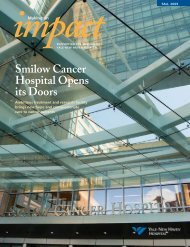
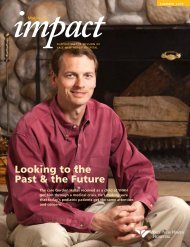

![Annual Report Donor Listings [pdf] - Yale-New Haven Hospital](https://img.yumpu.com/49673575/1/190x245/annual-report-donor-listings-pdf-yale-new-haven-hospital.jpg?quality=85)

